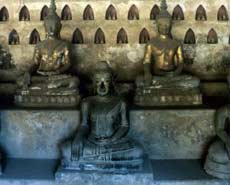Laos
Background
A closely guarded secret for nearly 20 years, Laos has only recently begun to receive visitors. Landlocked and wedged uncomfortably between Thailand, Vietnam, China, Cambodia and Burma (Myanmar), Laos is something of a rustic poor relation trapped in a time warp.
An hour flight from the steamy crush of Bangkok, Laos is a country of jungles, mountains and valleys frothing with mist and a tiny population of 4 million -- an incarnation of Thailand 40 years ago.
Novelty and comparative inaccessibility make it a magnet for travelers who hope to boldly go where few have gone before.
"The Land of the Million Elephants and the White Parasol" has always bewitched visitors, with its gentle people, colourful hilltribes, elegant temples, abundant natural beauty and unhurried pace of life.
Religion is still a vital part of life and every month sees uniquely Lao festivals combining Buddhist and ancient animist beliefs.
Laos was the least significant country in French Indochina, whose colonists referred to it as an earthly paradise and adopted a policy of "benign neglect". This has left a legacy of appalling roads, no railways, and practically non-existent infrastructure, which in its own way, add immensely to the country's charm.
Highlights
Vientiane
The capital of Laos, Vientiane, is often described as a quiet, dusty backwater on the banks of the Mekong. It is comparable in size with Nong Kai, the provincial Thai town on the other side of the river.
In the 16th century King Settathirath decided that Luang Prabang, the previous capital, was too remote for effective administration and transformed Vientiane from a market town into what became one of the most dazzling cities in Indochina.
Vientiane had a chequered history through the 18th and 19th centuries, sacked and occupied by the Siamese in 1778 and again in 1828. Forty years later, the French explorer Garnier found uninhabited ruins invaded by encroaching jungle. Resettlement began in 1890 and Vientiane was once again an administrative centre under the French by 1930.
Luang Prabang
The ancient royal and religious capital of Laos, Luang Prabang is up-river from Vientiane, an hour by plane. The city is tucked in at the confluence of the Mekong and Nam Khan rivers and consists largely of a single long street stretching from the ancient temple of Xieng Thong at one end to the morning market at the other.
Even compared with the rest of Laos, Luang Prabang is an oasis of tranquility, with its encircling hills, its dozens of temples, and the ever-present lazy power of the Mekong. Until a couple of years ago motor cycles were a rarity and hardly anyone drove a car in town. Many compare it to Chiang Mai 30 years ago.
The Plain of Jars
The Plain of Jars, at 1000m high, is famous for the mysterious stone "jars" scattered across the plateau, some as much as two metres tall, and about which legends abound. Stories tell of a race of giants who used them as drinking vessels, but most archaeologists believe that they are ancient funeral urns.
Transport
The roads in Laos are few and usually destroyed by the annual monsoon. There are no railways, so almost the only means of transport between provinces is to fly.
River travel is becoming easier, especially between Vientiane, Luang Prabang and northwards. The Mekong is navigable for much of its length in the south as well.
In towns there are few cars, although the number is rising rapidly. Bicycles, samlors (cycle rickshaws) and motor cycles are the usual mode of transport. There are also buses. These are mostly lorries with rudimentary seating inside. Some roads, such as Vientiane to Luang Prabang, were considered unsafe to travel because of security risks but are now open to free travel.




